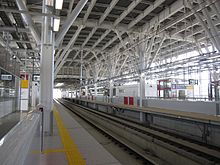Shin-Aomori Station
Shin-Aomori 新青森 | |||||
|---|---|---|---|---|---|
 East entrance, September 2014 | |||||
| General information | |||||
| Location | Ishie, Aomori-shi, Aomori-ken Japan | ||||
| Operated by | |||||
| Line(s) | |||||
| Connections | Bus stop | ||||
| History | |||||
| Opened | 1986 | ||||
| Passengers | |||||
| FY2013 | 8,162 daily | ||||
| |||||
Shin-Aomori Station (新青森駅, Shin-Aomori-eki) is a railway station in the city of Aomori, Aomori Prefecture, Japan, operated by the East Japan Railway Company (JR East).
Lines
Shin-Aomori Station is served by the Ōu Main Line, and is located 480.6 km from the southern terminus of the line at Fukushima Station. From 4 December 2010, it became the northern terminus of the Tohoku Shinkansen.[1]
Station layout
The conventional Ōu Main Line has a single island platform, serving two tracks. In addition to regular Ōu Main Line trains, the station serves two round-trips per day of regular Aoimori Railway trains, as well two round-trips of the irregular Resort Asunaro (direct to Noheji and the Ōminato Line). With the opening of the Tōhoku Shinkansen extension on 4 December 2010, it is also the southern terminus of Hakuchō Limited express services to Hakodate via the Tsugaru Kaikyō Line.
The Shinkansen station, opened on 4 December 2010, consists of two island platforms serving four tracks. The platforms are 263 meters long and capable of handling 10-car trains.[2]
Previously, Shin-Aomori Station was an unmanned station consisting of a single side platform for bi-directional traffic.
Platforms


| 1 | ■ Ōu Main Line | for Aomori |
| 2 | ■ Ōu Main Line | for Hirosaki and Akita |
| 11-14 | ■ Tohoku Shinkansen | for Hachinohe, Morioka, Miyagi, and Tokyo |
Adjacent stations
| ← | Service | → | ||
|---|---|---|---|---|
| Tohoku Shinkansen | ||||
| Shichinohe-Towada, Hachinohe, or Morioka |
Hayabusa Hayate |
Terminus | ||
| Hokkaido Shinkansen | ||||
| through to Tohoku Shinkansen | - | Okutsugaru-Imabetsu | ||
| Ōu Main Line | ||||
| Terminus | Super Hakucho Hakucho |
Aomori | ||
| Hirosaki | Tsugaru | Aomori | ||
| Tsugaru-Shinjō | Rapid | Aomori | ||
| Tsugaru-Shinjō | Local | Aomori | ||
History

Shin-Aomori Station opened on 1 November 1986 as a station on the Japanese National Railways (JNR). With the privatization of JNR on 1 April 1987, it came under the operational control of JR East. Work on a new station building began in July 2007, and was completed in 2010 ahead of the opening of the Tohoku Shinkansen extension on 4 December.
Future developments
Plans exist to continue the shinkansen line to Shin-Hakodate-Hokuto as part of the Hokkaido Shinkansen by 2016, and eventually to Sapporo around 2030. Once the Hokkaido Shinkansen extension opens from this station, Hakucho and Super Hakucho services will no longer serve this station.
Passenger statistics
In fiscal 2013, the station was used by an average of 8,162 passengers daily (boarding passengers only).[3][4] The passenger figures for previous years are as shown below.
| Fiscal year | Daily average | Total | |
|---|---|---|---|
| (Conventional) | (Shinkansen) | ||
| 2010 | 1,083[5] | - | 1,083 |
| 2011 | 2,730[6] | - | 2,730 |
| 2012 | 3,319[7] | 4,571[8] | 7,890 |
| 2013 | 3,639[3] | 4,523[4] | 8,162 |
Surrounding area
- Aomori-Nishi High School
- Shinjo Elementary School
- Galatown Aomori West Mall
- Aomori Kenko Land
See also
References
- Harris, Ken and Clarke, Jackie. Jane's World Railways 2008-2009. Jane's Information Group (2008). ISBN 0-7106-2861-7
- ^ JR East press release: "東北新幹線八戸~新青森間の開業時期について" (10 November 2008). Retrieved on 11 November 2008. Template:Ja icon
- ^ Misawa, Manabu (January 2010). "東北新幹線・九州新幹線 建設状況最新レポート". Tetsudō Daiya Jōhō Magazine. Vol. 39, no. 309. Japan: Kōtsū Shimbun. pp. 29–35.
- ^ a b 各駅の乗車人員 (2013年度) (in Japanese). Japan: East Japan Railway Company. 2014. Retrieved 15 February 2015.
{{cite web}}: Unknown parameter|trans_title=ignored (|trans-title=suggested) (help) - ^ a b 新幹線駅別乗車人員 (2013年度) (in Japanese). Japan: East Japan Railway Company. 2014. Retrieved 15 February 2015.
{{cite web}}: Unknown parameter|trans_title=ignored (|trans-title=suggested) (help) - ^ 各駅の乗車人員 (2010年度) (in Japanese). Japan: East Japan Railway Company. 2011. Retrieved 15 February 2015.
{{cite web}}: Unknown parameter|trans_title=ignored (|trans-title=suggested) (help) - ^ 各駅の乗車人員 (2011年度) (in Japanese). Japan: East Japan Railway Company. 2012. Retrieved 15 February 2015.
{{cite web}}: Unknown parameter|trans_title=ignored (|trans-title=suggested) (help) - ^ 各駅の乗車人員 (2012年度) (in Japanese). Japan: East Japan Railway Company. 2013. Retrieved 15 February 2015.
{{cite web}}: Unknown parameter|trans_title=ignored (|trans-title=suggested) (help) - ^ 新幹線駅別乗車人員 (2012年度) (in Japanese). Japan: East Japan Railway Company. 2013. Retrieved 15 February 2015.
{{cite web}}: Unknown parameter|trans_title=ignored (|trans-title=suggested) (help)

